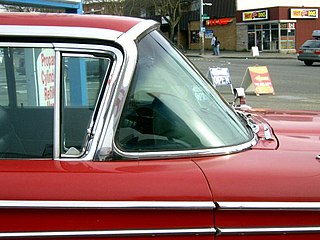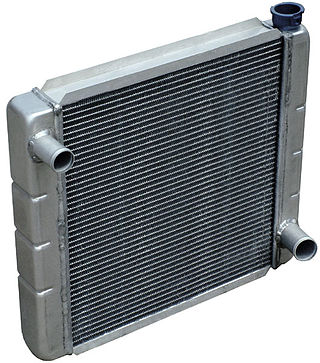
Methanol is an organic chemical compound and the simplest aliphatic alcohol, with the chemical formula CH3OH. It is a light, volatile, colorless and flammable liquid with a distinctive alcoholic odor similar to that of ethanol, but is more acutely toxic than the latter. Methanol acquired the name wood alcohol because it was once produced chiefly by the destructive distillation of wood. Today, methanol is mainly produced industrially by hydrogenation of carbon monoxide.

Ethylene glycol is an organic compound with the formula (CH2OH)2. It is mainly used for two purposes: as a raw material in the manufacture of polyester fibers and for antifreeze formulations. It is an odorless, colorless, flammable, viscous liquid. It has a sweet taste, but is toxic in high concentrations. This molecule has been observed in outer space.

The windshield or windscreen of an aircraft, car, bus, motorbike, truck, train, boat or streetcar is the front window, which provides visibility while protecting occupants from the elements. Modern windshields are generally made of laminated safety glass, a type of treated glass, which consists of, typically, two curved sheets of glass with a plastic layer laminated between them for safety, and bonded into the window frame.

A windscreen wiper or windshield wiper is a device used to remove rain, snow, ice, washer fluid, water, or other debris from a vehicle's front window. Almost all motor vehicles, including cars, trucks, buses, train locomotives, and watercraft with a cabin—and some aircraft—are equipped with one or more such wipers, which are usually a legal requirement.
An antifreeze is an additive which lowers the freezing point of a water-based liquid. An antifreeze mixture is used to achieve freezing-point depression for cold environments. Common antifreezes also increase the boiling point of the liquid, allowing higher coolant temperature. However, all common antifreeze additives also have lower heat capacities than water, and do reduce water's ability to act as a coolant when added to it.
Internal combustion engine cooling uses either air or liquid to remove the waste heat from an internal combustion engine. For small or special purpose engines, cooling using air from the atmosphere makes for a lightweight and relatively simple system. Watercraft can use water directly from the surrounding environment to cool their engines. For water-cooled engines on aircraft and surface vehicles, waste heat is transferred from a closed loop of water pumped through the engine to the surrounding atmosphere by a radiator.

Denatonium, usually available as denatonium benzoate and as denatonium saccharinate (BITTERANT-s), is the most bitter chemical compound known, with bitterness thresholds of 0.05 ppm for the benzoate and 0.01 ppm for the saccharinate. It was discovered in 1958 during research on local anesthetics by T. & H. Smith of Edinburgh, Scotland, and registered under the trademark Bitrex.
Methanol fuel is an alternative biofuel for internal combustion and other engines, either in combination with gasoline or independently. Methanol (CH3OH) is less expensive to sustainably produce than ethanol fuel, although it is more toxic than ethanol and has a lower energy density than gasoline. Methanol is safer for the environment than gasoline, is an anti-freeze agent, prevents dirt and grime buildup within the engine, has a higher ignition temperature and can withstand compression equivalent to that of super high-octane gasoline. It can readily be used in most modern engines. To prevent vapor lock due to being a simple, pure fuel, a small percentage of other fuel or certain additives can be included. Methanol may be made from fossil fuels or renewable resources, in particular natural gas and coal, or biomass respectively. In the case of the latter, it can be synthesized from CO2 (carbon dioxide) and hydrogen. The vast majority of methanol produced globally is currently made with gas and coal. However, projects, investments, and the production of green-methanol has risen steadily into 2023. Methanol fuel is currently used by racing cars in many countries and has seen increasing adoption by the maritime industry.

Mary Elizabeth Anderson was an American real estate developer, rancher, viticulturist, and most notably the inventor of what became known as the windshield wiper. On November 10, 1903 Anderson was granted her first patent for an automatic car window cleaning device controlled from inside the car, called the windshield wiper. Her patent didn't get far as she got no manufacturing firms to agree to make her invention.
Bullsone is an automotive products company headquartered in Seoul, Korea.

A heater core is a radiator-like device used in heating the cabin of a vehicle. Hot coolant from the vehicle's engine is passed through a winding tube of the core, a heat exchanger between coolant and cabin air. Fins attached to the core tubes serve to increase surface area for heat transfer to air that is forced past them by a fan, thereby heating the passenger compartment.
The following outline is provided as an overview of and topical guide to automobiles:
Weatherstripping is the process of sealing openings such as doors, windows, and trunks from the waters above. The term can also refer to the materials used to carry out such sealing processes. The goal of weatherstripping is to prevent rain and water from entering entirely or partially and accomplishes this by either returning or rerouting water. A secondary goal of weatherstripping is to keep interior air in, thus saving energy on heating and air conditioning.

Trico is an American company that specializes in windshield wipers. Trico, then known as Tri-Continental Corporation, invented the windshield wiper blade in 1917. Its original Trico Plant No. 1 is listed on the National Register of Historic Places. Trico is today one of the leading manufacturers of windshield wiping systems, windshield wiper blades and refills globally, with wiper plants on five continents.
A motor vehicle service or tune-up is a series of maintenance procedures carried out at a set time interval or after the vehicle has traveled a certain distance. The service intervals are specified by the vehicle manufacturer in a service schedule and some modern cars display the due date for the next service electronically on the instrument panel. A tune-up should not be confused with engine tuning, which is the modifying of an engine to perform better than the original specification, rather than using maintenance to keep the engine running as it should.
Ethylene glycol poisoning is poisoning caused by drinking ethylene glycol. Early symptoms include intoxication, vomiting and abdominal pain. Later symptoms may include a decreased level of consciousness, headache, and seizures. Long term outcomes may include kidney failure and brain damage. Toxicity and death may occur after drinking even in a small amount as ethylene glycol is more toxic than other diols.
Rain-X is a synthetic hydrophobic surface-applied product that causes water to bead up and run off surfaces, most commonly used on glass automobile surfaces. The brand has since been extended to a range of automotive and surface care products, including wiper blades.

Radiators are heat exchangers used for cooling internal combustion engines, mainly in automobiles but also in piston-engined aircraft, railway locomotives, motorcycles, stationary generating plants or any similar use of such an engine.
Old World Industries (OWI) is an American automotive and chemical company best known for their PEAK brand of motor oil, antifreeze and other automotive products. The company markets itself as an "independent, family-owned business". It sells products in over 60 countries.









